A Step By Step Methodical Approach for Efficient Mixed-Language IP Integration
By Pankaj Singh (Infineon Technologies) & Gaurav Kumar Verma (Mentor Graphics)
Abstract--The wide variety of design languages available today poses a significant barrier to IP reuse. SystemC, SystemVerilog, and conventional HDL languages have unique strengths which make them more suitable for writing certain portions of a design or IP. Designers also often choose a language based on their past experience. This frequently leads to portions of designs written in different languages being integrated in a single design. IP available from different sources may also come in different flavors. Connecting such IP requires special skills, in terms of expertise in all the different languages involved, which is not always easy to find. The wide variety of options available to make these connections further increases the complexity of the problem.
The above challenge necessitates the need for a methodology that compares the different ways of making mixed-language connections (such as direct instantiation, the SystemVerilog bind construct, SystemC control/observe, SC Verification-connect, and SC-DPI) and defines their pros and cons, providing precise information to help users select the best approach for their particular SoC.
In the past, most of the work was done by EDA companies to develop tools that understand mixed-language design for simulation but very little has been done toward providing a comprehensive methodology that highlights best practices, thereby minimize mixed-language design integration issues. Only relevant available work written on mixed language IP reuse [1] used direct instantiation and SystemVerilog bind methods without providing solution/benefits of other alternate approaches or comparing the two against each other.
This paper looks at mixed-language design integration from both the EDA tool developers’ and designers’ perspectives. It describes different approaches and provides useful insights to help users select the best option for integrating two IP blocks in a mixed-language environment. We will provide practical examples based on real designs.
The methodology presented in this paper is further used to develop a utility that takes the two regions, written in different languages, as input and automates the hook-up connection process by suggesting the most suitable approach. It also generates snippets of code that can be automatically inserted in the design to make these connections seamless and less prone to the kind of errors that may result from manual updates. The paper contains a working prototype of this utility, highlighting productivity improvement results from real-world, mixed-language design integrations.
I. INTRODUCTION
IP reuse has long been touted as one of the key factors in enabling development of today’s complex SoC designs. The concept of reuse seems simple and easy in theory, but there are a number of obstacles that design and verification teams must address to be successful, especially in the case of commercial IP cores. One of the significant barriers to IP reuse today is the wide variety of design languages used in IP.
Often designers are not aware of various mixed-language design integration options. Other times the knowledge on various options is available, but it is difficult for a user to choose the best suitable option based on their mixed language design scenario. This difficulty in mixed-language IP integration and reuse often leads to finding issues late during the design cycle, which impacts the overall productivity.
This paper provides a comprehensive methodology that highlights the best practices for mixed-language design integration and automatically comes up with an option for designers to select the optimal method for integration. There are broadly five ways of making mixed-language connections. Pros and cons of each of these approaches and their comparison is described in terms of the usage scenarios, performance implications of using one versus the other, delta cycle value update concerns, and more. A step-by-step guideline based on decision-making trees that designers can follow to help them decide which approach best suits their particular mixed-language integration scenario is also discussed.
The paper starts with details on various options for connections of mixed-language IP blocks, illustrating each method with a common example. It also includes a summary of comparisons between different methods. The third section elaborates on a step-by-step methodical approach for integration. The fourth and fifth sections cover the details about the utility that automates the IP integration. The last section highlights the benefits of this methodology.
II. METHODS TO CONNECT MIXED-LANGUAGE IP BLOCKS
In this section we will introduce each of the five methods for making mixed-language connections and discuss their pros and cons. A comparison of different approaches will also be provided to help determine the best suitable IP reuse option for a user based on the design scenario.
A. Direct Instantiation
In the direct instantiation method, an IP block written in any language is instantiated directly inside the target IP block (written in any language) within the SoC. Here the instantiation statement follows the syntax of the target IP block, as if the instantiated IP block was written in the same language as the target IP block.
This method is the most commonly used for making mixed-language connections as it offers seamless integration with the rest of the code. However, because of the nature of its use-model, it requires that the source code of the target IP block is available. This significantly limits the usability aspect of this otherwise powerful method in real-world IP reuse situations.
Example:
Clock Generator IP Block
module clockgen # (parameter period = 5 …)
(input period, input delay, input duty_cycle, output clk);
...
endmodule
Instantiating Clock Generator IP Block inside VHDL Stimulus Generator
clockgenInst: entity clkgenlib.clockgen port map(clk => clk);
B. SystemVerilog Bind Construct
The SystemVerilog bind construct provides an IP block access to both external ports and internal signals in the target IP block. The selected and target IP blocks can be written in any design language. This method provides a powerful capability that, together with a specifically designed use-model, can be used to conveniently connect the two IP blocks independent of their languages.
The SystemVerilog bind construct is increasingly becoming the preferred method for connecting IP blocks in SoC's today, as it offers hook-up connections between two IP blocks without requiring their source code to be present.
However, mixed-language the SystemVerilog bind construct has not been standardized yet, and as such, it is not fully compatible with all the available simulators. What may work with a simulator from one EDA vendor cannot be guaranteed to work with the simulator of another EDA vendor. Besides this limitation, EDA vendors also differ in their use models.
Also, since bind is a SystemVerilog construct, it must be used only in the SystemVerilog regions of the SoC. For instance, if a user wishes to connect a VHDL IP block with a SystemC IP block, an intermediate dummy SystemVerilog wrapper module will have to be created to use the bind construct, which may not be a very efficient approach. These factors somewhat restrict the usage of this otherwise powerful method of making connections.
Example:
Clock Generator IP Block
module ClockGen # (parameter period = 5) (input output clk);
...
endprogram
Binding Clock Generator IP Block to SystemC Stimulus Generator
bind StimGen ClockGen clockgenInst(.clk(clock));
C. SystemC Control/Observe
SystemC control/observe is a powerful construct that allows connection of signals across the hierarchy of a SystemC IP block to any other signal across the hierarchy of another IP block written in SystemVerilog or HDL. It can also be used on pre-compiled SystemVerilog and HDL IP blocks, but the SystemC IP block where SystemC control/observe constructs are used must have source-code visibility. This method cannot be used on compiled IP blocks.
Secondly, it requires the full hierarchical path of the source and destination objects, increasing the complexity. Also, since this method creates a jumper to connect the two signals across IP blocks, specialization and parameterization of IP blocks is not possible when this method is used. All these factors and its requirement for a non-compiled SystemC IP block somewhat restrict the usability of this otherwise useful construct.
Example:
Clock Generator IP Block
module clockgen # (parameter period = 5) (input output clk);
...
endprogram
Using SC Control/Observe to Connect Clock inside SystemC Stimulus Generator
clk.observe_foriegn_signal(“/clkgeninst/clk”);
D. SystemC Verification Connect
SCV-connect is the standard version of SystemC control/observe for IP blocks that include the SystemC Verification Library. It is not as optimized as the SystemC control/observe method and requires the SystemC Verification library to be included in the IP.
Example:
Clock Generator IP Block
module clockgen #(parameter period = 5) (input output clk);
...
endprogram
Using SCV_Connect to Connect Clock inside SystemC Stimulus Generator
scv_connect(clk, “/clkgeninst/clk”, SCV_INPUT);
E. SC-DPI
The SystemC Direct Programming Interface (SC-DPI) method provides an interface between SystemVerilog and SystemC that facilitates inter-language function calls. This means a SystemVerilog IP can call a function defined in a SystemC IP, and vice versa. It is a fast and suitable technique of connecting SystemVerilog IP blocks with SystemC IP blocks that have their external interfaces defined in the form of methods only.
Example:
SystemC Stimulus Generator
sc_module (sc_stimgen) {
...
return_status gen_stim(void);
...
};
Importing the SystemC Method ‘gen_stim' in SystemVerilog:
import "SC-DPI" function return_status gen_stim();
Summary of Comparison between Different Approaches
The table [1] below provides comparison between different approaches for making mixed-language connections. Various important aspects, such as usage scenarios, performance implications of using one versus the other, delta cycle value update concerns, etc. are listed for comparison.
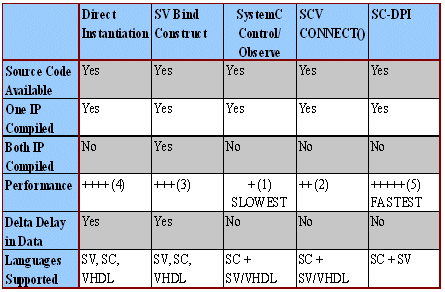
Table [1]: Summary of Comparison between Different Approaches
III. METHODOLOGY FOR MIXED LANGUAGE IP INTEGRATION
This section presents a 3-step methodical approach that helps users select the best option for integrating two IP blocks in a mixed-language environment.
STEP 1: Understanding the IP Blocks
As the first step towards deciding which approach to use, designers should:
- identify the design languages of IPs
- check the availability of source code of IPs
At the end of this stage the designer will have a clear understanding of the two IPs that are to be connected.
STEP 2: Understanding the Connections
After gathering information about the two IP blocks, designers should further:
- Analyze and list down the connections that are required to hook-up the two IP blocks together.
All connections can be broadly divided into four categories.
CATEGORY A
All connections are confined to one, and only one, design-unit in the two IP’s, respectively.
For example:
| IP BLOCK 1 | IP BLOCK 2 |
| Clk | Clock |
| Reset | Reset |
| Data | Data |
CATEGORY B
All connections are confined to one, and only one, design unit in one IP block but are distributed across the hierarchies spanning through multiple design units in the other IP block.
For example:
| IP BLOCK 1 | IP BLOCK 2 |
| Clk | top.axicore1.clk |
| Reset | top.axicore2.reset |
| Data | Data |
CATEGORY C
All connections are distributed across the hierarchies spanning through multiple design units in both the IP blocks.
For example:
| IP BLOCK 1 | IP BLOCK 2 |
| top.axistimgen.clk | top.axicore1.clk |
| top.axistimgen.reset | top.axicore2.reset |
| Data | Data |
CATEGORY D
All connections are through method ports only.
STEP 3: Finalizing the Method
This is the most important step of the proposed methodology where the designers will zero-in on the best method to connect the two IP blocks.
This step goes through a comparison of available methods, elimination of methods, and mixing method routines to arrive at an optimized approach.
Elimination: As the first step, designers should eliminate the choices which cannot be used at all to connect their two IP’s together, purely on the basis of the nature of the IP’s or the connections required.
The following table can be used for this elimination process:
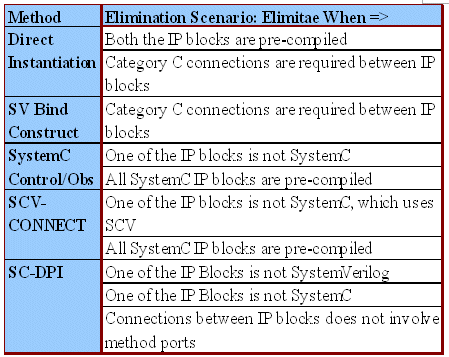
Table [2]: Elimination process for optimal method selection
Mixing Methods: There may be situations where elimination results in elimination of all the available choices. In such situations, designers will have to use more than one method to connect their IP blocks. Sometimes mixing methods can also lead to more optimized connections than following one single method.
Comparison of Choices: After the elimination and mixing methods steps, designers will be left with one or more choices. They can then use details provided in Table [1], Section II (Methods to Connect Mixed Language IP Blocks) to select the best approach for their SoC.
IV. PROPOSED MIXED LANGUAGE INTER CONNECT UTILITY
The methodology presented in this paper is used to develop a mixed language Inter Connect Utility (ICU) that takes the two IP blocks written in different languages as input and automates the hook-up connection process by suggesting the most suitable approach, while taking the minimum input from the user. It also generates snippets of code that can be automatically inserted in the design to make these connections seamless and less prone to errors that may result from manual updates.
Designer Configuration File
A Designer Configuration File (DCF) can be provided with the utility to automate it even further. This designer configuration file (DCF) will have information about the two regions to be connected, port-maps of the two regions, name of the output generated, and so on.
Figure [1] depicts Inter connect Utility Step 1; parsing and identifying the design
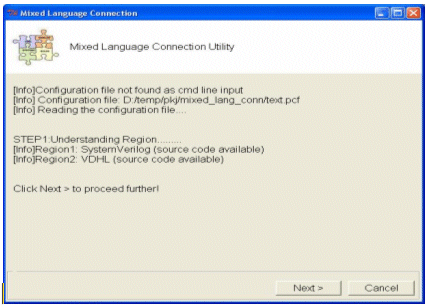
Figure [1]: Snapshot of ICU Step1
At the end of the ICU run, an option will be provided to store the DCF containing all the settings that were gathered or requested from the user in this run. The stored DCF can also be edited by the user to make small changes in his bindings as per the requirement for subsequent ICU runs.
Snapshots of Inter Connect Utility below show the Step 2 and Step3 process (described in section III) of analyzing and making IP connections.
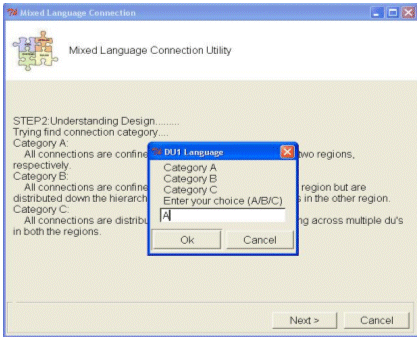
Figure [2]: Snapshot of ICU Step2
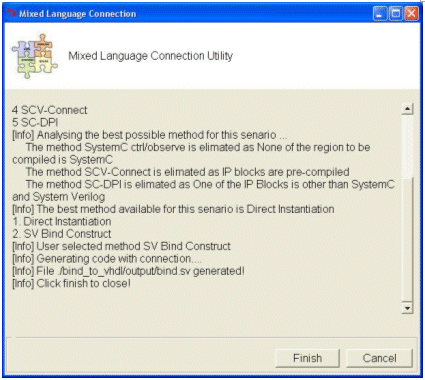
Figure [3]: Snapshot of ICU Step3
V. USING THE MIXED LANGUAGE INTERCONNECT UTILITY ON REAL WORLD DESIGN
Initial results on a small design indicate time savings in comparison to manual integration effort, with the additional benefit of removing the dependency on user’s knowhow of various integration methods by automatically analyzing and proposing the best option.
VI. CONCLUSION
The step by step methodology presented in this paper eliminates the limiting factor of IP reuse due to the complexity of mixed language designs.
The main benefits of the proposed methodology are twofold:
- Removing the basic issue with “how to” interconnect mixed-language IP’s by analyzing several standardized/non-standardized methods and proposing the best option with the highest benefit and minimal risk.
- Improving the productivity by minimizing issues found late during the design cycle due to incorrect interconnect approach or manual error in IP integration. The proposed utility selects and automates most of the process of mixed language IP hook-up connection. It also provides flexibility to the user to select his choice of method.
REFERENCES
[1] Rudra Mukherjee and Sachin Kakkar, “System Verilog – VHDL Mixed Design Reuse Methodology”, DVCon 2006.
[2] Rajeev Ranjan, Homayoon Akhiani, et al. “Towards Harnessing the True Potential of IP Reuse”, DesignCon 2009
[3] Rudra Mukherjee, Gaurav Kumar Verma, Arnab Saha, "SystemC Mixed-HDL IP Reuse Methodology", IP-07
[4] Gaurav Kumar Verma & Rudra Mukherjee, “SystemVerilog-VHDL-SystemC Verification IP Reuse Methodology”, IP-08
IMPORTANT NOTE
The utility presented in this paper is a standalone tool to help users automate connecting their mixed-language IP’s. As of today, there are no plans to add this utility in Questa
AUTHOR BIOGRAPHY
Pankaj Singh completed his Bachelors in Electronics from REC Bhopal in 1993; Master’s in Electrical Engineering from USF, Florida in 1997 and MBA from SMU, Dallas in 2001. He has 16 years of industry experience which includes work with Texas Instruments, ST Microelectronics and Infineon Technologies. Pankaj has published 12+ technical papers in various international conferences. In the past he has worked in various design leadership roles such as IP development Manager, Full chip SoC Design Manager, and Design flow department head.
Currently he is working with Infineon India as Senior Manager with focus on System, Functional Verification and Software Infrastructure activities and can be reached at pankaj(dot)singh(at)infineon.com
Gaurav Kumar Verma completed his Bachelors in Electrical Engineering from Indian Institute of Technology Delhi in 2003. He has more than 6+ years of experience in the EDA industry, specializing in coverage-driven verification and mixed-language simulation methodologies. He has several technical papers and articles in various international conferences and industry leading publications.
Currently he is working with Mentor Graphics as a Member of Consulting Staff and can be reached at gaurav-kumar_verma(at)mentor.com
Index Terms
- SC-DPI : SC Direct Programming Interface
- SCV : SystemC Verification
- DCF : Designer Configuration File
- ICU : Inter Connect Utility
Related Semiconductor IP
- HBM4 PHY IP
- Ultra-Low-Power LPDDR3/LPDDR2/DDR3L Combo Subsystem
- MIPI D-PHY and FPD-Link (LVDS) Combinational Transmitter for TSMC 22nm ULP
- HBM4 Controller IP
- IPSEC AES-256-GCM (Standalone IPsec)
Related Articles
- Careful IP Integration Key to First-Pass Silicon
- A cost-effective and highly productive Framework for IP Integration in SoC using pre-defined language sensitive Editors (LSE) templates and effectively using System Verilog Interfaces
- The common silicon issues in analog IP integration
- Mastering Key Technologies to Realize the Dream - M31 IP Integration Services
Latest Articles
- ElfCore: A 28nm Neural Processor Enabling Dynamic Structured Sparse Training and Online Self-Supervised Learning with Activity-Dependent Weight Update
- A 14ns-Latency 9Gb/s 0.44mm² 62pJ/b Short-Blocklength LDPC Decoder ASIC in 22FDX
- Pipeline Stage Resolved Timing Characterization of FPGA and ASIC Implementations of a RISC V Processor
- Lyra: A Hardware-Accelerated RISC-V Verification Framework with Generative Model-Based Processor Fuzzing
- Leveraging FPGAs for Homomorphic Matrix-Vector Multiplication in Oblivious Message Retrieval